BladeRunnerJS comes with in-built support for internationalization. Below are the details required to add internationalization support to your BRJS application.
Basic App Setup
For this example we'll assume you've created an application called demo, created a bladeset called blades and created a blade called myblade. Within that blade, open up the resources/html/view.html template and update it to look as follows:
<div class="locale-demo-blade" id="demo.blades.myblade.view-template">
<h1>Internationalization Demo</h1>
<div class="hello-world-message" data-bind="text:message"></div>
</div>
Now, open up the ViewModel file for the blade, MybladeViewModel.js, and update it to match the following:
'use strict';
var ko = require( 'ko' );
function MybladeViewModel() {
this.message = ko.observable( 'Hello World!' );
}
module.exports = MybladeViewModel;
Run the workbench for the blade and it should look like this:

Set up Supported Locales
Have a look in app.conf within the application root directory. It defines the locales that your app will support.
requirePrefix: <namespace>
locales: en, de, es
If you ensure that there is more than one locale at this point, then refresh the browser, you will see that the locale now appears within the URL. The Understanding how locale switching is handled in BRJS section explains the subtleties of how this works.
Include the Internationalization Bundler
Include the Internationalization Bundler in your app's index.html and workbench (myblade/workbench/index.html), by adding the i18n.bundle line into your index.html file.
<head>
<meta charset="UTF-8">
<title>Workbench</title>
<@css.bundle theme="standard"@ />
<!-- new code -->
<@i18n.bundle@/>
<!-- end of new code -->
</head>
Internationalizing via HTML
Let's update the <h1> element inside our HTML, which will be automatically internationalized. Internationalization markup in BRJS takes the form of: @{<token>}. It's best to namespace your token so that other blades don't overwrite each other's tokens.
<div class="locale-demo-blade" id="demo.blades.myblade.view-template">
<h1>@{demo.blades.myblade.title}</h1>
<div class="hello-world-message" data-bind="text:message"></div>
</div>
Then define the token translation inside the file myblade/resources/i18n/en/en.properties.
demo.blades.myblade.title=Internationalization Demo
Refresh the workbench, and it should look like this:

The token replacement works by replacing all i18n tokens in all HTML as it is streamed through the HTML Bundler.
Internationalizing via JavaScript
Let's add an internationalized property to the blade's view model at myblade/src/demo/blades/myblade/MybladeViewModel.js.
'use strict';
var ko = require( 'ko' );
/*** new code ***/
var i18n = require( 'br/I18n' );
/*** end of new code ***/
function MybladeViewModel() {
/*** new code ***/
var text = i18n( 'demo.blades.myblade.helloworldmessage' );
this.message = ko.observable( text );
/*** end of new code ***/
}
module.exports = MybladeViewModel;
Refreshing the application will result in a message that indicates the requested property could not be found:
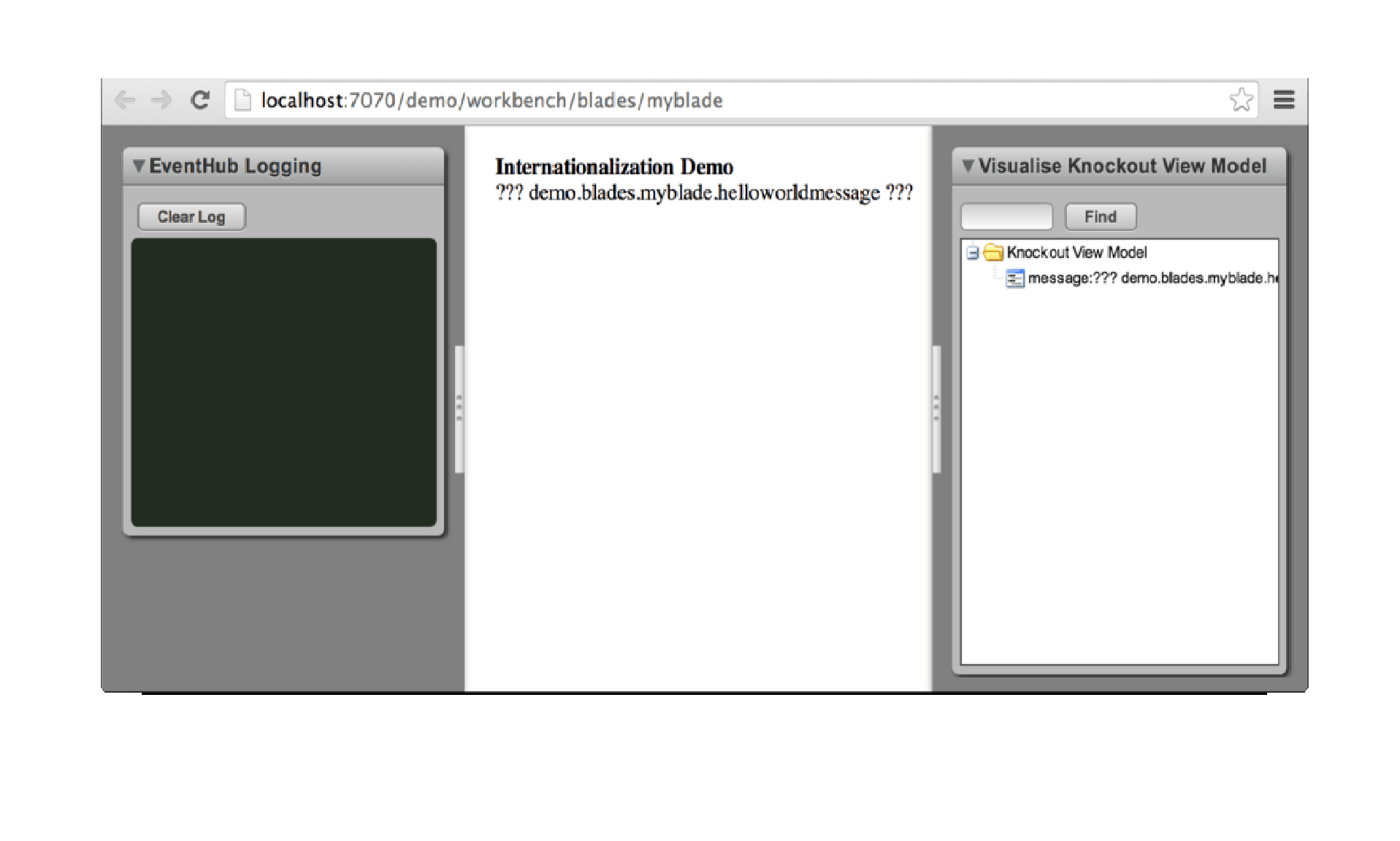
To fix this add the translation to the i18n resource file.
demo.blades.myblade.title=Internationalization Demo
/*** new code ***/
demo.blades.myblade.helloworldmessage=Internationalized Hello World!
/*** end of new code ***/
After a refresh of the blade workbench, your token should have been replaced, and it should look like this:

Add a New Language
Create a file myblade/resources/i18n/de/de.properties file, containing:
demo.blades.myblade.title=Internationalisierung Demonstration
demo.blades.myblade.helloworldmessage=Internationalized Hallo Welt!
Loading the app with a German locale set in the browser, will display like this:
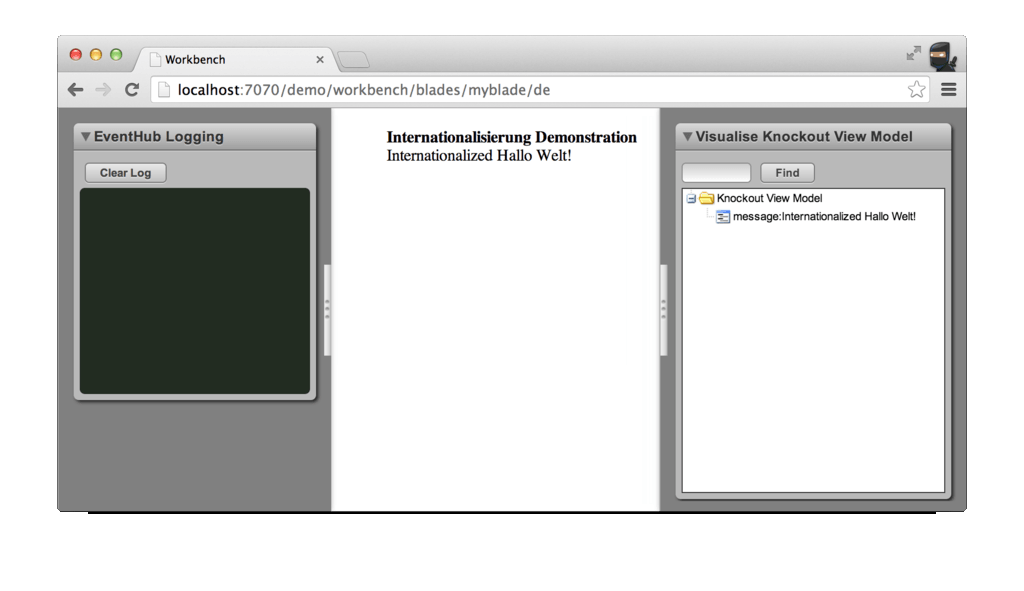
Local Date Format
By default BRJS supports English, German and Chinese locale date formats. It is possible to add additional customized date formats too.
For this example we'll demonstrate English and German date formats.
Localized dates can be retrieved using the date function from the i18N module. Update MybladeViewModel as follows:
'use strict';
var ko = require( 'ko' );
/*** new code ***/
var i18n = require( 'br/I18n' );
/*** end of new code ***/
function MybladeViewModel() {
/*** new code ***/
var epochDate = new Date( 1970, 0, 1 );
var formattedDate = i18n.date( epochDate );
/*** end of new code ***/
var text = 'The epoch date was ' + formattedDate;
this.message = ko.observable( text );
}
module.exports = MybladeViewModel;
The English output and formatted date looks as follows:

And the German:

If we want to see dates with times down to the second we need to change the date format. In order to change the date format you need to update the locale settings for the aspect, and those settings are inherited by the blade. This is because date formats should almost always be the same throughout the application rather than differing from blade to blade, so the date formats are defined up at the aspect level.
Update the English properties file, found in resources/i18n/en/en.properties to define a br.i18n.date.format:
br.i18n.date.format=DD, MMMM YYYY hh:mm:ss
And do the same for the German properties file, found in resources/i18n/de/de.properties:
br.i18n.date.format=DD, MMMM YYYY hh:mm:ss
With these changes in place the English date format will be updated:

As will the German:
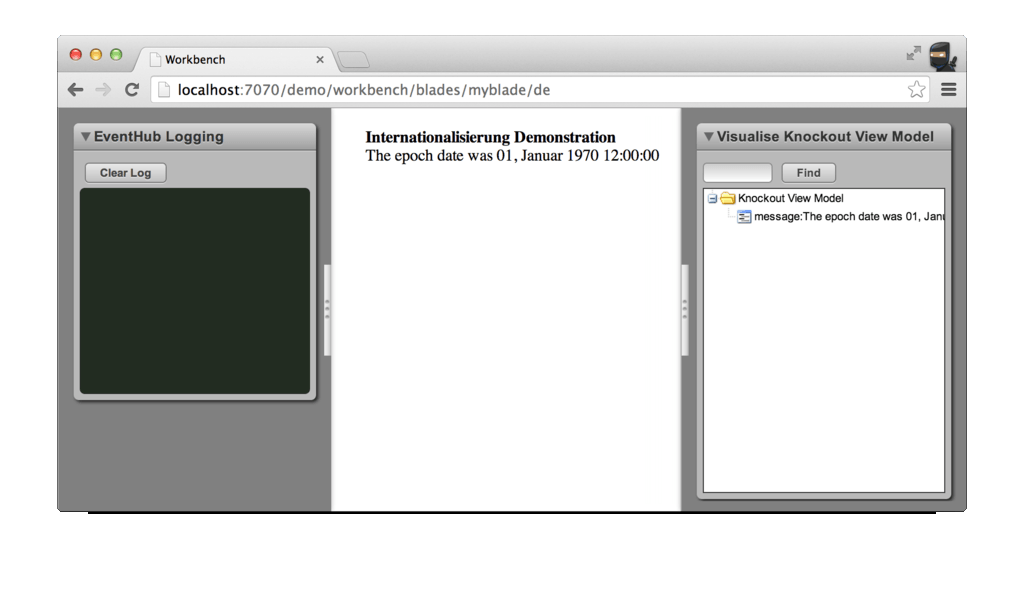
Note: you'll probably be thinking that the German version has English text hard-coded. We'll fix this later using Parameterized Translations.
Local Number Format
Number formatting too is subject to locale. If we were to display a large numerical value within our blade it's nicer to format this with the appropriate thousands separator character and decimal point character.
Note that formatting of numbers falls under the remit of internationalization because the characters differ by locale. In English we use the comma as a thousands separator and the full stop as a decimal point, but in French the space is used as a thousands separator and comma is used for the decimal point. German uses the full stop as a thousands separator.
To format a number to the user's locale, we can use the number function. To demonstrate this we can display the number of milliseconds since the epoch in addition to the epoch timestamp.
'use strict';
var ko = require( 'ko' );
var i18n = require( 'br/I18n' );
function MybladeViewModel() {
var epochDate = new Date( 1970, 0, 1 );
var formattedDate = i18n.date( epochDate );
/*** new code ***/
var millisSinceEpoch = i18n.number( Date.now() );
/*** end of new code ***/
var text = 'The epoch date was ' + formattedDate;
/*** new code ***/
text += ' This is ' + millisSinceEpoch + 'ms ago.';
/*** end of new code ***/
this.message = ko.observable( text );
}
module.exports = MybladeViewModel;
Now the format of the milliseconds since the epoch differs according to the locale used; English:
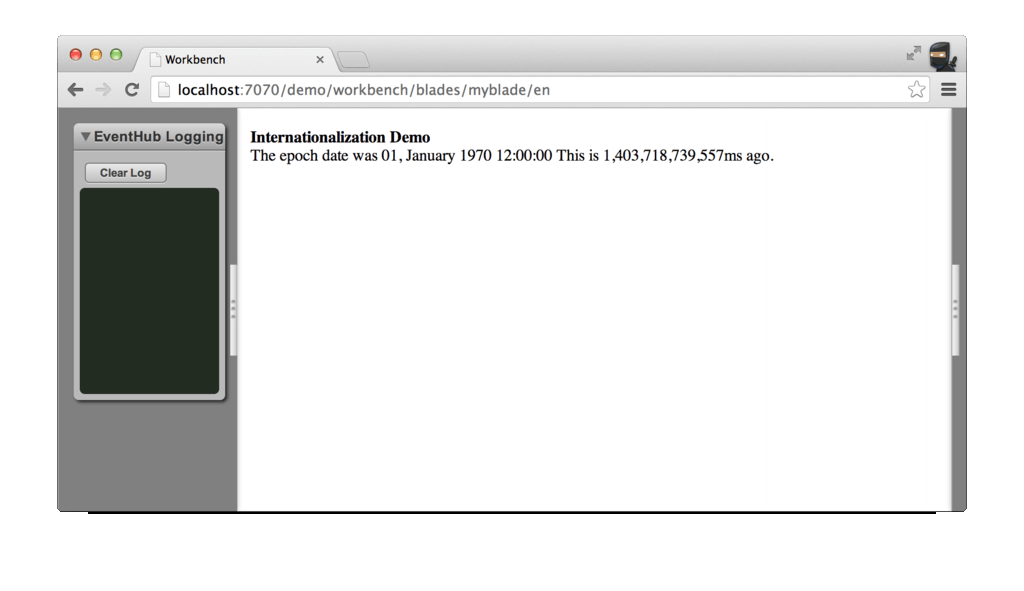
And German:

Parameterized Translations
The i18n library also allows you to make "parameterized translations". This involves defining an i18n property containing tokens, and then passing in the values for those tokens when you call the translator.
Update the en.properties file so that there is a demo.blades.myblade.epochmessage that uses timestamp and epochmillis parameters:
demo.blades.myblade.epochmessage=The epoch date was [timestamp]. This is [epochmillis]ms ago.
Do the same with de.properties:
demo.blades.myblade.epochmessage=Die Epoche Datum war [timestamp]. Dies ist vor [epochmillis]ms.
Within the messages the parameters are identified by square brackets. When you call the translator, you can pass in the values that should be inserted in place of these parameters.
The parameters are passed as a map object of token name and token value. The map is passed into the translator in addition to the ID of the i18n property you want to use. Here's the updated MybladeViewModel.js :
'use strict';
var ko = require( 'ko' );
var i18n = require( 'br/I18n' );
function MybladeViewModel() {
var epochDate = new Date( 1970, 0, 1 );
var formattedDate = i18n.date( epochDate );
var millisSinceEpoch = i18n.number( Date.now() );
/*** new code ***/
var params = {
timestamp: formattedDate,
epochmillis: millisSinceEpoch
};
var text = i18n( 'demo.blades.myblade.epochmessage', params)
/*** end of new code ***/
this.message = ko.observable( text );
}
module.exports = MybladeViewModel;
And here's what the result looks like in English:

And German:

Localized CSS
The CSS used in your application can also be locale specific. For instance, we may want to set the background with national colors or increase the dimensions of elements containing text where words and sentences may be longer in different languages.
To do this creates files called color_en.css for the English locale and colors_de.css for the German in the standard/themes/standard directory. Here you can set the locale-specific css. Note that locale-specific theme css overrides general theme css so let's first define the shared styles in myblade/themes/standard/style.css:
.locale-demo-blade {
width: 250px;
font-family: helvetica;
padding: 20px;
text-align: center;
}
.locale-demo-blade h1,
.locale-demo-blade .hello-world-message {
padding: 5px;
}
.locale-demo-blade .hello-world-message {
line-height: 22px;
}
In color_en.css add the following content:
.locale-demo-blade {
background-color: red;
color: white;
}
.locale-demo-blade h1 {
background-color: blue;
color: white;
}
.locale-demo-blade .hello-world-message {
background-color: white;
color: black;
}
Loading the application with the English locale will show this:

Finally in color_de.css add the following content:
.locale-demo-blade {
background-color: black;
color: white;
}
.locale-demo-blade h1 {
background-color: red;
color: white;
}
.locale-demo-blade .hello-world-message {
background-color: gold;
color: black;
}
And loading the German locale will show the following:

Useful Tips
Example Application
The full KnockoutJS BRJS Example Todo MVC example demonstrates how to use i18n within and application.
Missing Translations
If you miss out a translation, then the i18n makes it pretty obvious to you.
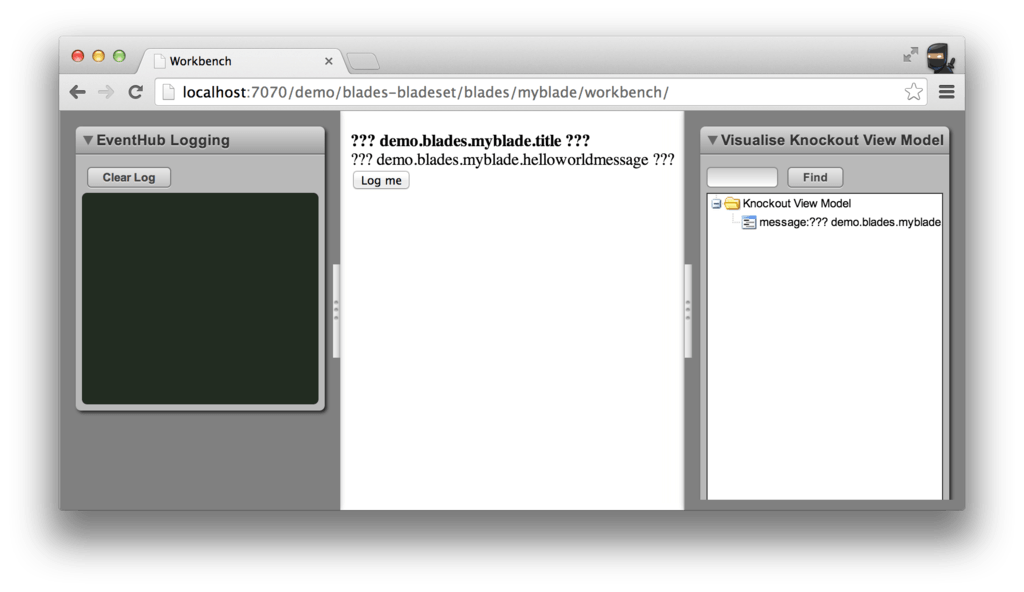
I18n at Different Levels
You can internationalize at different levels of your application, by locating property files under the different levels in their resource folders
- Aspect:
/app/aspect/resources/i18n - BladeSet:
/app/bladeset/resources/i18n - Blade:
/app/bladeset/blade/resources/i18n
Understanding how locale switching is handled in BRJS
Before we continue we first need to understand how locale switching is handled depending on the type of app in use. For the purposes of internationalization, there are three types of app:
- Single-Locale Apps
- Multi-Locale Apps (forwarding style)
- Multi-Locale Apps (non-forwarding style)
Single-Locale Apps
Single-Locale apps define only a single locale within their app.conf configuration file. For such apps, the served index page for apps and workbenches is the very same source index page that you will edit yourself, but with any logical tags replaced with their proper contents.
Accordingly, single-locale apps never display the locale within the URL.
Multi-Locale Apps
Multi-Locale apps return a switching-page instead of the source index page you normally edit. Instead, one copy of the source index page is created for each of the locales you define within app.conf.
For example, if you define locales: en, de within your app.conf, then the following pages will be created:
index.html(contains the switching-page)en.html(contains an English version of the source index page)de.html(contains a German version of the source index page)
The switching page defers to the br.locale-provider service to determine the active-locale, and the br.locale-switcher service to switch to the active locale, allowing some flexibility in how locales are dealt with.
BRJS comes pre-loaded with two implementations of the br.locale-switcher service:
BRLocaleForwardingSwitcherfor forwarding style apps (the default).BRLocaleLoadingSwitcherfor non-forwarding style apps.
Forwarding Multi-Locale Apps
Forwarding style multi-locale apps cause the browser to load the active locale at a new URL. Although this causes the locale to appear within the URL, this is the default option as it has a number of advantages:
- The browser's view-source feature continues to work.
- The browser's debugging tools tend to work better.
- The page can be introspected, and understood by developers familiar with HTML.
Non-Forwarding Multi-Locale Apps
Non-forwarding style apps have the following advantages:
- The locale doesn't appear within the URL.
- Bookmarks continue to work even if the locale changes.
and can be enabled within your app by replacing this:
<alias name="br.locale-switcher"
defaultClass="br.services.locale.BRLocaleForwardingSwitcher"/>
in your aliasDefinitions.xml file, with this:
<alias name="br.locale-switcher"
defaultClass="br.services.locale.BRLocaleLoadingSwitcher"/>
Understanding how the active locale is determined in BRJS
When a request is made to /myapp/ a locale-switching page is returned to the browser which uses the br.locale-provider service to determine the active locale. A single implementation of this service is provided with BladeRunnerJS, which works as follows:
- If the
localestoragecontains alocalekey, then this is used. - Otherwise, the browser's
Accept-Languageheader is matched against the locales actually provided by the app, and the first match is used, assuming there is a match. - If there were no matches, then the first locale defined within
app.confis used.
The determined active locale is then stored within localstorage ready for the next time the app is loaded.
Given that the implementation of br.locale-provider may be changed in the future, overriding the active locale should be performed using the public API, and not by updating localstorage directly. This can be performed within code as follows:
require('br-locale/switcher').switchLocale(myLocale);
You are also free to provide your own implementation of the br.locale-provider service. For example, if you'd prefer the user's locale to be stored along with the user's settings on the server, so that they automatically get their preferred locale even when they login using a new computer or device.